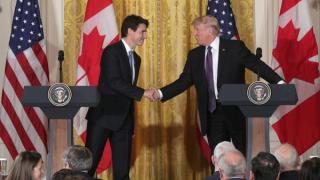NAFTA is here to stay – for now.
Known for its competing factions and abrupt changes of heart, the Trump administration’s decision to hold off on withdrawing from the North America Free Trade Agreement, the trilateral agreement between the US, Canada, and Mexico was no exception.
Derided during his campaign as “the worst trade deal maybe ever signed anywhere, but certainly ever signed in this country”, Trump also showed moments of a more moderate take on NAFTA, particularly after meetings with Mexican President Enrique Pena Nieto and Canadian Prime Minister Justin Trudeau, when he spoke of modernising it instead of getting rid of it entirely.
Yet the decision to withdraw supposedly got far enough that White House staff had already drafted an executive order for leaving NAFTA before the president had a last minute change of heart.
President Trump has now pledged – for the time being, at least – to work with Canada and Mexico to “bring NAFTA up-to-date through renegotiation”. This could very well be another example of the Trump tactic of bellicose rhetoric setting up a better negotiating position to get a better deal. This is, after all, the self-identified expert of getting a deal and the stakes for a US trade deal with its number one and two export markets – bigger than its next 10 biggest export markets combined – could not be higher.
Nearly a quarter century old, all sides agree that the NAFTA needs to be updated. The economy has changed dramatically from when NAFTA was negotiated and signed in the early 1990s. The advent of the Internet and the Digital Age has fundamentally changed our lives, yet NAFTA does not address our modern times. Any effective trade agreements for today’s economy must take current economic components into account – ranging from the growth of cross border shopping to rules for digital data and products.
Such a modern and updated trade deal has actually already been negotiated. It incorporated stricter labour laws and environmental protections and even included Australia, among other nations. But it was not good enough for President Trump as he decided three days into his presidency to withdraw from the agreement known as the Trans Pacific Partnership.






